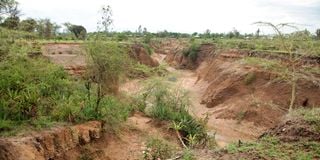Plea for help as gullies threaten to wipe out village

Katuk Odeyo Gullies in Nyakach, Kisumu County on May 6.
What you need to know:
- From a distance, one might miss giant pits, infamously known here as Katuk-Odeyo gullies, the result of extreme soil erosion and a nightmare in villages here. The depressions, some as deep as 20 metres, stretch for more than 20 kilometers across Jimo and Agoro villages.
- The result has been the displacement of tens of families from their ancestral homes over the years, injury to both man and beast, as erosion continues to wreak havoc. The wrath of Mother Nature has not spared the dead either, with rainwater sweeping graves and skeletons downstream.
In the early 1970’s, Nyakach Agoro in Kisumu County was one of the areas in Kenya with a booming cotton production business. With the rich black cotton soil that supports growth of the cash crop, the farmers built a cotton store at Jimo to facilitate storage and movement of the product.
More than50 years later, however, the land remains bare and isolated. The location of the main stage, Sito Pamba, which loosely means ‘‘cotton store’’ located along the Katito-Sondu road is the only remaining evidence of the once-booming cotton business here.
Farms that thrived with the cotton crop here now lie bare, with only a handful of acacia and other indigenous trees spread out on the otherwise empty marshland.
From a distance, one might miss giant pits, infamously known here as Katuk-Odeyo gullies, the result of extreme soil erosion and a nightmare in villages here. The depressions, some as deep as 20 metres, stretch for more than 20 kilometers across Jimo and Agoro villages.
What was once an access road to Kericho County, residents say, is now a giant valley that incises across the village, disappearing and reappearing at different points along the course of the five major gullies and their extensions.
The result has been the displacement of tens of families from their ancestral homes over the years, injury to both man and beast, as erosion continues to wreak havoc. The wrath of Mother Nature has not spared the dead either, with rainwater sweeping graves and skeletons downstream.
Deep in the acacia fields, the Healthy Nation team catches up with 65-year-old Agoro village resident Erick Omolo grazing his animals. The old man is forced to graze the animals next to the dangerous valleys despite the high risk of deadly slips and falls.
“I have lost more than 10 animals in these gulleys. Some have fractured body parts and forced us to sell them to butcheries at throwaway prices,” Erick recounts, adding that residents live in fear of loss every day.
The man is among the hundreds of victims of the environmental catastrophe here, forcing him to relocate twice. The genesis of the disaster, he says, was in the 1960s. No one knew what would follow over the years.
“We had water to play with as young boys and would occasionally swim in the shallow water pans. The pits kept stretching and widening as years went by. After sometime, villagers started to get worried,” he notes.
Thirty years later, Erick was displaced from his seven-acre land in Jimo even as his family stayed behind. In early 2000, the family woke up to a catastrophe.
“When we woke up, the graveyard and skeletons of my brother’s wife and nephew had been swept away,’’ he narrates, dejected.
In this area, no one ventures out at night lest they fall into the gulleys. Mobility is also a challenge, with residents sometimes having to make detours of up to 10 kilometres due to the valleys. Some sections are inaccessible by vehicles.
It is even worse for school children who often have to walk for long distances, leaving them exhausted.
‘‘The school is located near the village but the gulley separates them. They have to go round the gulley, which is very far,’’ say Andrew Juma, a resident.
“Last year, I carried my ailing mother on my back to hospital. She was too sick to move. She died on arrival at the hospital,’’ Juma laments, teary.
The man believes his mother’s life would have been saved had it not been for the long distance.
For Nancy Akinyi, the rugged terrain is the reason children are admitted to school late to avoid accidents.
While many organisations have come here to establish the root cause of the erosion and look for remedies , Nancy says they quit soon after without a solution.
Left on their own, villagers have had to engage in tree planting activities and building a dam, initiatives that are yet to bear fruits. “Our leaders always promise to help by building bridges to ease movement only for them to disappear once elected,” says Omolo.
Nyakach MP Aduma Owuor, though, argues that the level of damage here is beyond the scope of constituency resources, calling on support from the Ministry of Environment.
‘‘The gullies pose as a risk to humans and livestock, they also act as a hiding place to animal thieves who often terrorise the villagers,” says the MP.
“I have been lobbying the national government to come to our rescue but very little has been done. Our residents are suffering,” he adds.
Meanwhile, Kisumu County National Environment Management Authority boss Tom Togo says human activities are to blame for the environmental degradation. “As a result the weak soil, which is always bare, gets easily washed during the heavy rains contributing to the massive erosion,” says Togo.
He notes that a long-term solution can only be found if the county and residents are engaged in a well-organised environment conservation exercise.
“It is time the county channelled more funds to the area for the conservation activities including tree planting,” he says.





